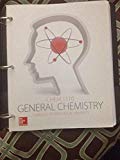
Concept explainers
(a)
Interpretation:
The pH for the given solutions has to be calculated
Concept Information:
Strong base and weak base:
Strong base dissociates into its constituent ions fully. It produces more of hydroxide ions while dissolved in water. Weak bases partially dissociates into its constituent ions.
According to Bronsted-Lowry, strong base is a good proton acceptor whereas weak base is a poor proton acceptor
Since, the ionization of a weak base is incomplete; it is treated in the same way as the ionization of a weak acid.
The ionization of a weak base
The equilibrium expression for the ionization of weak base
Where,
The
Relationship between
The relationship between the hydronium ion concentration and the hydroxide ion concentration is given by the equation,
As
To Calculate: The pH of the given solutions
To calculate the pH of 0.10 M
(a)
Answer to Problem 16.70QP
Answer
The pH of the given solution (a) is 11.11
Explanation of Solution
Record the given data
A 0.10-M solution of ammonia at
From the concentration and
Calculation of
The equilibrium table for ammonia can be constructed as follows,
|
| |||
|
Initial
|
|
|
|
|
Change
|
|
| |
|
Equilibrium
|
|
| |
Therefore, the concentration of hydroxide ion is
Calculation of pOH:
The pOH can be calculated as follows,
Calculation of pH
The pH can be calculated using the following formula as follows,
Therefore, the pH of 0.10 M ammonia solution is 11.11
(b)
Interpretation:
The pH for the given solutions has to be calculated
Concept Information:
Strong base and weak base:
Strong base dissociates into its constituent ions fully. It produces more of hydroxide ions while dissolved in water. Weak bases partially dissociates into its constituent ions.
According to Bronsted-Lowry, strong base is a good proton acceptor whereas weak base is a poor proton acceptor
Since, the ionization of a weak base is incomplete; it is treated in the same way as the ionization of a weak acid.
The ionization of a weak base
The equilibrium expression for the ionization of weak base
Where,
The
Relationship between
The relationship between the hydronium ion concentration and the hydroxide ion concentration is given by the equation,
As
To Calculate: The pH of the given solutions
To calculate the pH of 0.050 M pyridine
(b)
Answer to Problem 16.70QP
Answer
The pH of the given solution (b) is 8.96
Explanation of Solution
Record the given datas
A 0.050 M pyridine at
From the concentration and
Calculation of
The equilibrium table for ammonia can be constructed as follows,
|
| |||
|
Initial
|
|
|
|
|
Change
|
|
| |
|
Equilibrium
|
|
| |
Therefore, the concentration of hydroxide ion is
Calculation of pOH:
The pOH can be calculated as follows,
Calculation of pH
The pH can be calculated using the following formula as follows,
Therefore, the pH of 0.050 M pyridine solution is 10.48
Want to see more full solutions like this?
Chapter 16 Solutions
Chemistry: Atoms First V1
- Can I get helpp drawing my arrowsarrow_forwardWhich of the m/z values corresponds to the base peak in the mass spectrum shown? 100 80 A. 45 B. 44 C. 29 D. 15 Intensity 20 0 10 20 30 40 B- m/z -8 50 E. 30 Which of the m/z values correspond to the molecular ion for the compound shown? A. 18 B. 82 OH C. 100 D. 102 E. 103arrow_forwardCan someone help me with drawing my arrows.arrow_forward
- I'm having trouble with converting lewis diagrams into VSEPR diagrams. I currently have this example of C2BrCl3 which I want to turn into a lewis structure, but I'm not sure what steps I need to do in order to do so. I have the table written down, however, there's two central atoms so what would I do? There seems to be 4 electron domains on the carbon atom and no lone pairs so it would seem like this shape would be tetrahedral. Here's what I have now. Thanks!arrow_forwardWe discussed the solid phase resin using in peptide synthesis. Provide a mechanism, for its formation. DRAW THE MECHANISM.arrow_forwardPlease help. Every time I've asked an expert in the past, it's been wrong :(arrow_forward
 Chemistry: Principles and ReactionsChemistryISBN:9781305079373Author:William L. Masterton, Cecile N. HurleyPublisher:Cengage Learning
Chemistry: Principles and ReactionsChemistryISBN:9781305079373Author:William L. Masterton, Cecile N. HurleyPublisher:Cengage Learning Chemistry: The Molecular ScienceChemistryISBN:9781285199047Author:John W. Moore, Conrad L. StanitskiPublisher:Cengage Learning
Chemistry: The Molecular ScienceChemistryISBN:9781285199047Author:John W. Moore, Conrad L. StanitskiPublisher:Cengage Learning Chemistry: Principles and PracticeChemistryISBN:9780534420123Author:Daniel L. Reger, Scott R. Goode, David W. Ball, Edward MercerPublisher:Cengage Learning
Chemistry: Principles and PracticeChemistryISBN:9780534420123Author:Daniel L. Reger, Scott R. Goode, David W. Ball, Edward MercerPublisher:Cengage Learning- Chemistry: Matter and ChangeChemistryISBN:9780078746376Author:Dinah Zike, Laurel Dingrando, Nicholas Hainen, Cheryl WistromPublisher:Glencoe/McGraw-Hill School Pub Co
 Chemistry & Chemical ReactivityChemistryISBN:9781337399074Author:John C. Kotz, Paul M. Treichel, John Townsend, David TreichelPublisher:Cengage Learning
Chemistry & Chemical ReactivityChemistryISBN:9781337399074Author:John C. Kotz, Paul M. Treichel, John Townsend, David TreichelPublisher:Cengage Learning Chemistry for Engineering StudentsChemistryISBN:9781337398909Author:Lawrence S. Brown, Tom HolmePublisher:Cengage Learning
Chemistry for Engineering StudentsChemistryISBN:9781337398909Author:Lawrence S. Brown, Tom HolmePublisher:Cengage Learning





